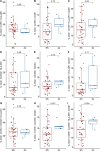Patterns of inflammation and immune activation by coreceptor use in people living with HIV-1
- PMID: 40709192
- PMCID: PMC12286835
- DOI: 10.3389/fimmu.2025.1632287
Patterns of inflammation and immune activation by coreceptor use in people living with HIV-1
Abstract
Introduction: Human immunodeficiency virus type 1 (HIV-1) utilizes either the CCR5 (R5) or CXCR4 (X4) coreceptor for host cell entry. Coreceptor switching from R5 to X4 and elevated immune activation have been associated with disease progression. X4-tropic HIV-1 is predominantly observed in the late stage of infection, when the immune environment characterized by chronic activation is optimal for their replication. The aim of this study was to determine viral tropism in late HIV presenters and who have not previously received treatment in Mexico City and its relationship with markers of chronic immune activation.
Methods: A cross-sectional study was conducted on 122 people living with HIV (PLWH) recruited from two public health services. Viral tropism was determined using next-generation sequencing (NGS) and the geno2pheno algorithm. Immune activation was assessed through flow cytometry (CD38+, HLA-DR+), and soluble markers (sCD14, sCD163, IL-6) were quantified using enzyme-linked immunosorbent assays (ELISA). Differences in immune activation patterns between R5 and X4 group were explored using Mann-Whitney Wilcoxon test and t-test, and a principal component analysis (PCA). Logistic regression was used to evaluate associations between immune activation profiles and the presence of X4-tropic viruses.
Results: Ninety-eight individuals had high-quality V3 loop sequences, 81.6% harbored only R5 variants (R5 group), while 18.4% had mixed R5/X4 populations (X4 group). Most PLWH had CD4+ T cell counts below 200 cells/µL, showing no significant difference between groups. Elevated levels of IL-6 were significantly associated with the R5 group (p = 0.01), while the X4 group showed increased expression of CD38+ and HLA-DR+CD38+ markers, although not statistically significant. Furthermore, IL-6 emerges as a negative predictor for the presence of X4 viruses (OR = 0.06, p = 0.006).
Conclusion: R5-tropic viruses are associated with elevated inflammatory responses in early stages, as indicated by higher IL-6 levels, while X4-tropic viruses may contribute to CD4+ T cell depletion through immune activation. Consequently, elevated levels of IL-6 emerge as a negative predictor for the presence of X4 viruses. The relationship between viral tropism and chronic immune activation in HIV-1 infection reflects a complex interplay which appears to be bidirectional.
Keywords: CCR5; CD38; CXCR4; HIV-1 tropism; HLA-DR; IL-6; chronic immune activation; next generation sequencing.
Copyright © 2025 Guerra-Castillo, Pinto-Cardoso, Ávila-Ríos, Chávez-Torres, Peralta-Prado, González-Torres, Gaytán-Cervantes, Requena-Benitez, Díaz-Rivera, Alaez-Verson, Hernández-García and Bekker-Méndez.
Conflict of interest statement
The authors declare that the research was conducted in the absence of any commercial or financial relationships that could be construed as a potential conflict of interest.
Figures




Similar articles
-
Covariation of Amino Acid Substitutions in the HIV-1 Envelope Glycoprotein gp120 and the Antisense Protein ASP Associated with Coreceptor Usage.Viruses. 2025 Feb 26;17(3):323. doi: 10.3390/v17030323. Viruses. 2025. PMID: 40143251 Free PMC article.
-
Diagnostic test accuracy and cost-effectiveness of tests for codeletion of chromosomal arms 1p and 19q in people with glioma.Cochrane Database Syst Rev. 2022 Mar 2;3(3):CD013387. doi: 10.1002/14651858.CD013387.pub2. Cochrane Database Syst Rev. 2022. PMID: 35233774 Free PMC article.
-
Existence of Replication-Competent Minor Variants with Different Coreceptor Usage in Plasma from HIV-1-Infected Individuals.J Virol. 2020 Jun 1;94(12):e00193-20. doi: 10.1128/JVI.00193-20. Print 2020 Jun 1. J Virol. 2020. PMID: 32295903 Free PMC article.
-
Falls prevention interventions for community-dwelling older adults: systematic review and meta-analysis of benefits, harms, and patient values and preferences.Syst Rev. 2024 Nov 26;13(1):289. doi: 10.1186/s13643-024-02681-3. Syst Rev. 2024. PMID: 39593159 Free PMC article.
-
Signs and symptoms to determine if a patient presenting in primary care or hospital outpatient settings has COVID-19.Cochrane Database Syst Rev. 2022 May 20;5(5):CD013665. doi: 10.1002/14651858.CD013665.pub3. Cochrane Database Syst Rev. 2022. PMID: 35593186 Free PMC article.
References
-
- UNAIDS . HIV and AIDS Estimates of people living with the virus in Mexico (2023). Available online at: https://www.unaids.org/es/regionscountries/countries/Mexico (Accessed June 6, 2025).
MeSH terms
Substances
LinkOut - more resources
Full Text Sources
Medical
Research Materials

